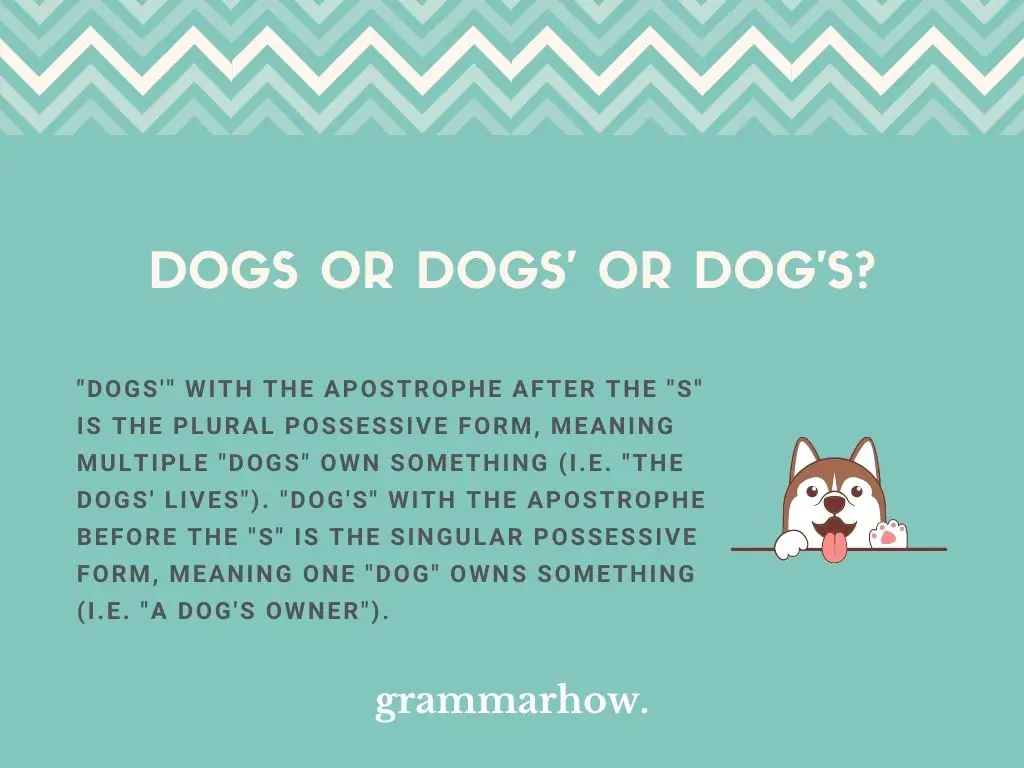Have you ever looked at “dogs,” “dog’s,” and “dogs'” and wondered what the different apostrophes are for? The possessive form is a tricky thing.
Luckily, we’ve got all the answers that will help you figure it out.
Dogs or Dogs’ or Dog’s?
“Dogs'” with the apostrophe after the “s” is the plural possessive form, meaning multiple “dogs” own something (i.e. “the dogs’ lives”). “Dog’s” with the apostrophe before the “s” is the singular possessive form, meaning one “dog” owns something (i.e. “a dog’s owner”).

Check these forms out to see which one is which:
| Singular | Dog |
| Plural | Dogs |
| Singular possessive | Dog’s |
| Plural possessive | Dogs’ |
The singular form becomes the singular possessive form when an “‘s” is added to the end. This is standard grammar for most regular nouns. You should include the “‘s” ending to show that a dog owns an item (i.e. “the dog’s collar”).
The plural form becomes the plural possessive form with an apostrophe after the “s.” Since there’s already an “s” at the end of “dogs,” you can skip the “s” after the apostrophe (i.e. “the dogs’ owners”). You do not need a second “s” here because it would look strange to write “dogs’s.”
Dog’s
“Dog’s” is a simpler possessive form. It still allows a dog to own an object but only works with one dog. As the singular possessive form, “dog’s” shows one dog owning an object which comes after it.
You could find the item directly after “dog’s” like so:
- The dog’s collar is a bit tight. Would you like me to loosen it?
- Why have you not been to the dog’s kennel yet to check on him?
This is common, as it shows direct ownership. This makes the use of the apostrophe much clearer to the reader.
Dogs’
“Dogs'” is a slightly more complicated form. It is known as the plural possessive form, showing that many dogs own an object or group of objects. You would usually find the object directly after the plural possessive form (i.e. “the dogs’ collars”).
It’s very common for plural possessive forms to own plural objects. This helps make the plural form clearer to the reader, which is why it’s written in this way.
- The dogs’ kennels have to be cleaned before we return. They will not sleep in them otherwise.
- I’m not sure about all of the dogs’ dinners. Surely, they will want to eat something else.
Dogs
“Dogs” is not a possessive form at all. You cannot use it when a dog owns an item (which usually comes in the form of a noun directly after “dog”).
“Dogs” is the plural form instead. It is used to show multiple dogs in your writing. You can use it with quantifiers, such as “two dogs,” “these dogs,” or “most dogs.”
The moment you add an owned object to “dogs” is the moment it becomes a possessive form. The plural form is not a possessive form.
- I own multiple dogs. I love them all equally, and I would never be able to leave them.
- My dogs are going to stay at home while we go out. I’ll be back to check on them later.
Conclusion
“Dogs” is the plural form, showing multiple dogs within a sentence. No possession is used in this form.
“Dog’s” is the singular possessive form. One dog owns an object in this form.
“Dogs'” is the plural possessive form. Multiple dogs own similar objects or groups in this form.

Martin holds a Master’s degree in Finance and International Business. He has six years of experience in professional communication with clients, executives, and colleagues. Furthermore, he has teaching experience from Aarhus University. Martin has been featured as an expert in communication and teaching on Forbes and Shopify. Read more about Martin here.
